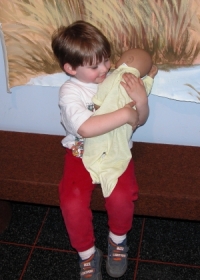 I try hard to avoid gender stereotypes with my kids. I know full well that my career over the last 30 years as a computer programmer was made possible by a woman. I also know that one the most hardcore overland adventurers I know is a woman. There seem to be a lot more male chefs on TV than women. And my daughter continually amazes me with her Herculean strength, even as my son impresses me with his empathy. And yet, it seems, children pick up on stereotypes as early as preschool even from the most innocent comments. Yes, it turns out that even “Good morning, boys and girls” is enough to induce gender awareness in preschoolers.
I try hard to avoid gender stereotypes with my kids. I know full well that my career over the last 30 years as a computer programmer was made possible by a woman. I also know that one the most hardcore overland adventurers I know is a woman. There seem to be a lot more male chefs on TV than women. And my daughter continually amazes me with her Herculean strength, even as my son impresses me with his empathy. And yet, it seems, children pick up on stereotypes as early as preschool even from the most innocent comments. Yes, it turns out that even “Good morning, boys and girls” is enough to induce gender awareness in preschoolers.
In a study conducted by developmental psychologist Lynn Liben and graduate student Lacey Hilliard from Pennsylvania State University, it was found that just making references to different genders — as in having separate bulletin boards to show off boys’ and girls’ work — resulted in children being more likely to agree with traditional gender stereotypes such as that dolls are for girls and only boys should become firefighters.
Mind you, the study was not huge — consisting of 57 students split among classrooms where the teachers did and did not reference gender — but the results were significant enough that, at the very least, more research should be done and, ideally, teachers and parent should begin avoiding gender-based language if they don’t already do so.
The problem with gender stereotypes, of course, is that such labels influence career choices and even what children see as their own strengths and weaknesses. This leads to kids shying away from professions in which they might excel and find great joy. Imagine if Gene Kelly had been told that dancing is for girls or if Madame Curie had been told that science is for boys. “I think it probably makes more sense,” says Liben, “to use ‘child’ language and ‘friend’ language, rather than ‘boys’ and ‘girls.'” I couldn’t agree more.
Tags: boys, gender, gender bias, girls, sex, stereotypes, studies

